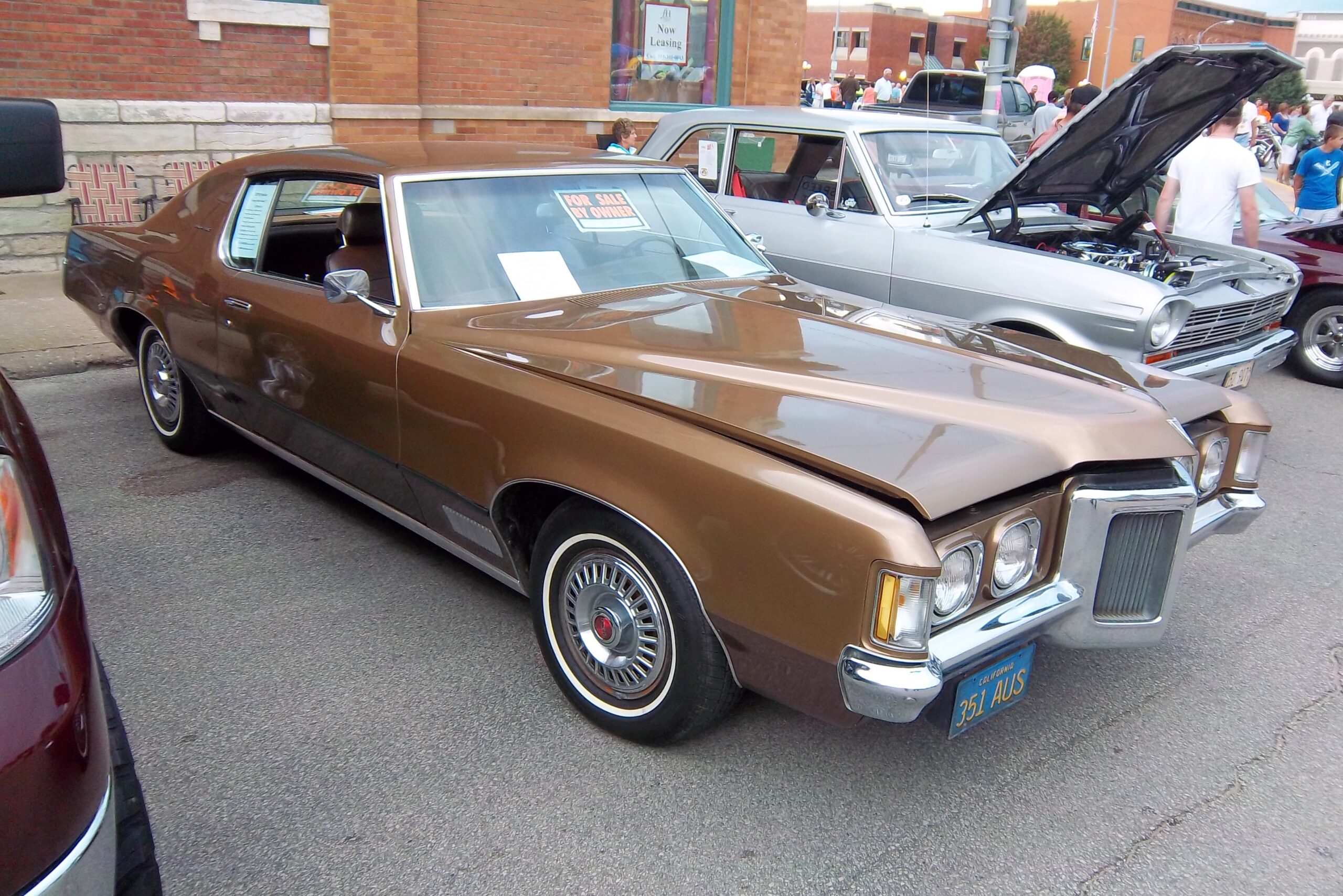
In the comments on my ’69 Grand Prix post yesterday, one of our commenters, dejal, mentioned that he wasn’t sure if he ever saw one of these sans vinyl top. I had a dim memory of spying one, and after work today dived into ‘The Vault’, to check.
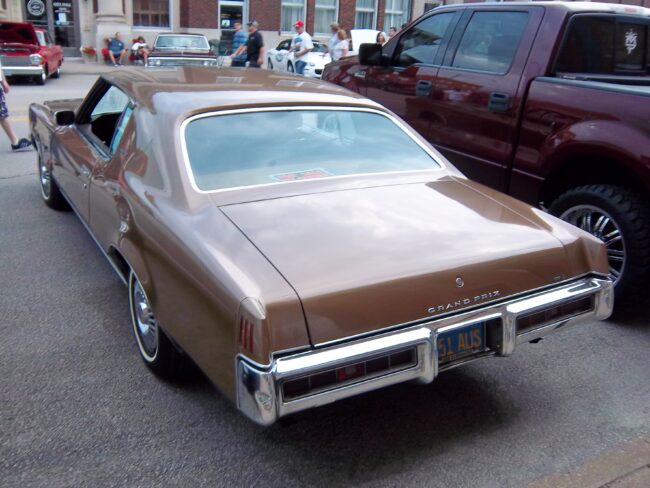
Sure enough, there was one, this 1970 model, which I saw at the Maple City Cruise Night in Monmouth, IL back in August 2013. As a matter of fact, these were the last four pictures I took that day, as it was rapidly getting dark.
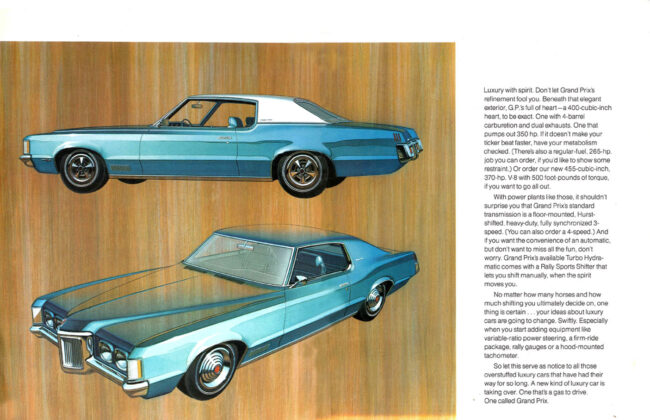
Of course, many, many of these GPs, being personal-lux coupes, had the then-ubiquitous vinyl roof. But it was optional. A slick top version was even shown in the 1970 Grand Prix brochure. But as was the custom in the late ’60s and early ’70s, probably ninety percent had the vinyl chapeau.
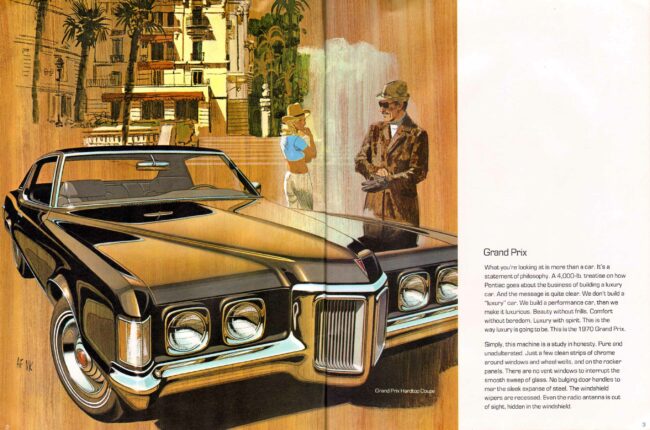
The 1970 was almost identical to the all-new 1969, but the grille pattern went from horizontal to vertical, and the taillights had a slight facelift. 65,750 were built for the year, much better than the old-style ’68’s 31,711, but way down from ’69’s 112,486.
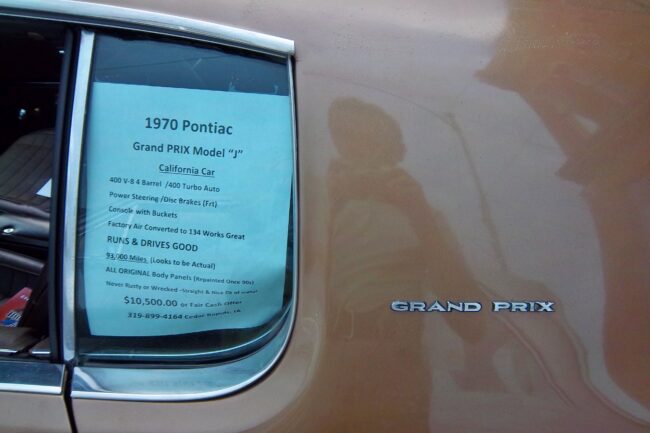
It was much darker than it appears in the photos, and I finally gave up. But at least I got this car captured! I only wish I’d spied it earlier that day, to get the usual 10-12 shots I accrue when I see a car I really like.

Anyway, here ’tis. Happy Friday. Now time for me to get back to my weekend routine. *BARTENDER*







23 Comments
A friend from High School had one, a green one, just like your advertisement.
Sadly, he wrecked it. He wrecked a LOT of cars (drunk or stoned driving) through school and into college. But his family had money, so…
His didn’t have a vinyl top either. They were really sweet cars.
I like these cars much better without the arbitrary hard line at the base of the vinyl top. This color combination(is it a combination when it is all just shades of soil?) does less than nothing for me, but the beauty of the car and the logic of its interior design shine through.
Not only does it look better without the vinyl top, but I suspect it contributed to its survival. I wonder how many vinyl roof cars from the 1960s to the 80s have to to the scrapper because the cracked vinyl let in moisture that rusted out the metal roof and leading to leaks and too expensive to repair damage. In the rust belt the rest of the car would have gone first, but in the sun belt I expect vinyl roofs rotted and leaked pretty quickly.
Vinyl tops definitely promoted rust in addition to having no positive qualities. The blue GP with the white top in the other article looks downright top heavy from some angles, in addition to having a discordant straight line that ruin the elegance of the C-pillar, the sweeping curve at the top of the quarter panel, and the integration of the roof into the body.
Thanks for the shoutout!
A truly beautiful automobile. I was driving a new 1969 Dodge Dart GTS 340 when the magazines began teasing full-page photos of the ’69 Grand Prix’s “cockpit” immediately rendering my car’s interior antiquated, with its painted metal dashboard and umbrella handle emergency brake. And yes, many of the early cars – including the ones in the ads and road tests – were slick tops, usually painted that now-classic metallic olive green that Pontiac was busy slathering on every third GTO. Without the vinyl the purity of the design stunned me.
The ideal driver’s station would look just like the one you photographed except it would sport a MOMO Prototipo look-alike Formula steering wheel, three pedals on the floor and a factory Hurst 4-speed sprouting from the console. And even though the ’69 Grand Prix was downsized to the intermediate platform shared with the GTO it was exempt from GM policy that limited the Goat to 400 cubic inches, so the GP could be optioned with a 428!
It was the first time I fell in lust with a car when I was ALREADY DRIVING my dream car… but it wouldn’t be the last!
Verdoro Green, really popular on Pontiacs 68-71.
This has the LeMans full wheelcovers, the GP had its one unique full wheelcovers, you can see them in the ad photos, but they must have not been able to find a set.
I don’t mid the halo top, though I would have to have the Rally II wheels, make mine an SJ with the 428, auto, cause its a cruiser, you could even order up the hood tach option on these like on the GTO.
These had some other oddities, the optional 8 track player was mounted on the end of the console in the back seat since there really wasn’t any other place for it.
The other rare version of these was the Hurst SSJ versions which had special two tone gold and white paint, and could have been ordered with crazy aftermarket options like a black and white TV.
I remember all of your observations, Carmine, except for the name of the color.
The concentric-circle full wheel covers would have almost tempted me to forgo the Rally IIs. Nah, who am I kidding?
Thanks for refreshing my memory!
GM made some nice looking steel wheels during this era with the Pontiac Rally II, Chevrolet and Buick Rallyes (different wheel with same name) as optional extras, and I always wondered whether they were actually cheaper for GM to produce than the full wheel cover alternatives, which were often pretty elaborate and heavy. If so it would have been the perfect profit booster by getting consumers to pay extra for a steel wheel that mimicked a fancy alloy/mag wheel, while actually being cheaper to produce than the combination of a unstyled steel wheel + wheel cover (that would fall off during hard cornering or when the tire store guy didn’t put back on correctly). I was always surprised the styled steel wheels weren’t more popular, but I guess the typical 50+ year old Buick or Pontiac buyer thought they were too sporty looking while the younger buyers were already stretched thin just buying a new car with a 3 year loan typical of the time to check off such a frivolous option (plus they could just buy a set of Cragers later on).
Carmine, you’re right, the GP had those wheel discs that looked like the ‘spats’ on wire-wheeled Classic cars of the 20s and 30s. I didn’t realize it had the wrong ones at the time.
If you didn’t have the right ones, that would be an excellent reason to add the Pontiac Rally wheels…
Talk about driver-centric, look at the position of the radio relative to the passenger seat!
No wonder I loved it!
I think it should be remembered when thinking about the vinyl top is that Pontiac already had the Tempest to appeal to the younger performance buyer, which was lighter, cheaper and offered the specialized models. This car was trying to bring in a more mature buyer who could handle the price point that remember was even higher $3866 in 69 versus $3813 for the full size 68 that in my opinion was one of the best looking fat pigs you will ever see.
The 60s car that really didn’t benefit from buying the vinyl top was the early Toronado. That fact that so many did anyway probably is a good indication of where the mature first owner market was.
Now if we could just convince Chysler to offer a Cordoba off the Challenger. The first factory vinyl top since 2009, it was a no cost option on the Bentley Arnage, would be a great wat to add a formal roofline on the cheap.
Absolutely. The Tornado didn’t have “shoulders” so the optional vinyl top broke the line of the rear quarter at an arbitrary point on the car’s flank.
The Olds was another car that looked best in its original form, paying homage as it did to the Cord 810/812, right down to the hidden headlights and slotted wheels – appropriate, as it was the first fwd American since the ’30s.
While subsequent facelifts never managed to completely ruin the Toronado’s good looks the stylists definitely lost the visual thread of a reincarnation of Gordon Beuhrig’s masterpiece.
And much like the original Saab Turbo of years later it seemed to come in one color: maroon!
Way back in the day I was told that all US Rolls-Royces came through with the vinyl top because it was a lot cheaper to cover unfinished metal seams with vinyl, than to grind them down and fill them. From where the Greenhouse attached to the lower body.
(And, BTW, it was avoiding that step that was the motivation for Ford, in the 1990s, to invent stamping out an entire car side from firewall to taillights, if I recall that correctly, and holding them together with the roof panel. I was told at the time that the transfer press to make that happen for the Mondeo was the size of a football field, and cost $95 million.)
If that was true: what cynicism, but… very believable, from the Brits.
john
(engineering and economics nerd)
On the RR, you might be thinking about the Silver Wraith that used a vinyl (everflex) roof to hide the seam where they added to the wheelbase so there could be a division window and use it as a limo. Interesting that it happened only 12 years in. The weird thing about about that chassis was that it kept reverting over the 44 year production run from too small to too big and back, but never just right. As a music guy, you might have noticed how the new rich invasion rockers usually bought one but quickly reverted, because they never felt comfortable in a place they didn’t belong. To me a sign of intelligence, lacking among the current. They should instead have tried a Grand Prix. Not a full on Corvette, you see what it did to the Def Leopard drummer.
The early cars had painted tops, they added it as mentioned above, when they stretched the wheelbase in the mid 70’s.
That 66-80 “Judge Smails” Rolls is the car that still sticks in my head when the name Rolls Royce comes up. They come up cheap from time to time, but they seem to be a pain in the ass for what you really get out of one.
If you own one of these you have to dress like the guy in the 2nd ad, like a racy Inspector Clouseau with OJ gloves that about to murder a blonde lady in Nice….
Funny!
I loved that guy’s illustrations though. Forget his name.
2 guys, Art Fitzpatrick and Van Kaufman, one did the car and the other did the backgrounds.
Damn, I remember that! As a published illustrator (Road & Track among others, years ago) I used to buy the Illustrators Annual every year and subscribe to Art Director, Communication Arts and Print magazines. Somewhere along the line I’d read about those guys!
It’s amazing how well their two distinctly different techniques blend so seamlessly. The translucent wash brushed over most of the Inspector Clouseau painting ties the styles together. The wash in the other illustration overlays the blue slick top but not the white vinyl roof car. That’s an easy effect to create in Photoshop but must have taken quite a coordinated effort on the part of the artists to achieve by hand with acrylics.
I collect old car brochures and the late ’50s to early ’70s Pontiac brochures are among my favorites, the Van and Fitz illustrations are amazing.
yes really great artwork in these old car ads!